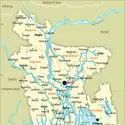MICROCRÉDIT
Article modifié le
Bibliographie
D. W. Adams, « Using credit unions as conduits for micro-enterprise lending: Latin-American insights », in Poverty-Oriented Banking Working Paper, no 12, Enterprise and Cooperative Development Department, International Labor Office, Genève, 1995
B. ArmendarizdeAghion& J. Morduch, The Economics of Microfinance, The MIT Press, Cambridge, 2005
I. Guérin, M. Labie& S. Morvant-Roux, « Inadequate growth, over-indebtedness, and crises in microcredit: what have we learned? », in Enterprise Development and Microfinance, vol. 29, no 2, p. 118-132, 2018 (doi : https://doi.org/10.3362/1755-1986.17-00013)
I. Guérin, M. Labie& J.-M. Servet dir., The Crises of Microcredit, Zed Books, Londres, 2015
S. Holcombe, Managing to Empower: the GrameenBank'sExperience of PovertyAlleviation, Zed Press, Londres, 1995
M. Hossain, Credit for Alleviation of Rural Poverty : the Grameen Bank in Bangladesh, IFPRI, Washington, 1988
D. Hulme, « Impact assessment methodologies for microfinance: theory, experience and better practice », in World Development, vol. 28, no 1, 2000
D. Hulme& P. Mosley, Finance Against Poverty, vol. 1 et 2, Routledge, Londres, 1996 ; « Microenterprise Finance: Is there a conflict between growth and poverty alleviation? », in World Development, vol. 26, no 5, 1998
S. R. Khandker, FightingPovertywithMicrocredit: Experience in Bangladesh, Oxford Univ. Press for the World Bank, 1998
R. E. Lucas, « Why doesn't capital flow from rich to poor countries? », in American EconomicReviewPapers and Proceedings, vol. 80, no 2, 1990
J. Morduch, « The Microfinance Promise », in Journal of EconomicLiterature, vol. 37, no 4, 1999
M. Otero& E. Rhyne, The New World of Microenterprise Finance, IT Publications, Londres, 1994
M. Pitt& S. R. Khandker, « The impact of group-based credit programs on poor houdeholds in Bangladesh : does the gender of participant matter ? », in Journal of PoliticalEconomy, vol. 37, no 4, 1998
J. Remenyi, WhereCreditis Due, IT Publications, 1991
S. R. Schuler, S M. Hashemi& A. P. Riley, « The Influence of women's changing roles and status in Bangladesh's fertility transition: evidence from a study of credit programs and contraceptive use », in World Development, vol. 25, no 4, 1997.
La suite de cet article est accessible aux abonnés
- Des contenus variés, complets et fiables
- Accessible sur tous les écrans
- Pas de publicité
Déjà abonné ? Se connecter
Écrit par
- Marie GODQUIN : docteure en économie
- Solène MORVANT-ROUX : docteure en économie
Classification
Autres références
-
AMAP (Association pour le Maintien de l'Agriculture Paysanne)
- Écrit par Jean-Paul CHARVET
- 3 014 mots
- 2 médias
...millions de personnes, soit environ 20 p. 100 de la population américaine. Du côté des producteurs, il existe depuis 2013 aux États-Unis un programme de microcrédit (Micro Loan Program) ayant pour objectif de faciliter l’installation, sur des exploitations maraîchères de quelques hectares, d’agriculteurs... -
BANGLADESH
- Écrit par Alice BAILLAT et Encyclopædia Universalis
- 8 410 mots
- 10 médias
Le développement économique et social du pays repose en partie sur la diffusion massive du microcrédit, depuis la création, en 1976, de la Grameen Bank par l’économiste bangladais Muhammad Yunus. Surnommé le « banquier des pauvres », il s’est vu décerner le prix Nobel de la paix en 2006 pour son combat...
Voir aussi



